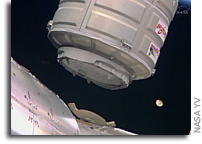NASA Kennedy, Florida Institute of Technology, MIT Experiment Among NASA Cargo on Space Station

An experiment designed by NASA’s Kennedy Space Center in Florida, the Florida Institute of Technology, and the Massachusetts Institute of Technology is among the cargo that arrived at the International Space Station Sunday on the Orbital-1 cargo resupply mission.
The experiment, entitled “SPHERES-Slosh,” is part of the SPHERES-Slosh payload.
This experiment seeks to examine how liquids move around inside containers in microgravity. This investigation will allow middle-school and high-school students to control the Synchronized Position Hold Engage Reorient Experimental Satellites (SPHERES) as part of a planned outreach program to continue to inspire the next generation of scientists and engineers.
Orbital-1 is NASA’s first contracted resupply mission to the space station by U.S. company Orbital Sciences Corp. of Dulles, Va. Orbital’s Cygnus spacecraft launched atop the company’s Antares rocket from NASA’s Wallops Flight Facility in eastern Virginia on Jan. 9. Expedition 38 crew members captured the Orbital-1 Cygnus using the space station’s robotic arm at 6:08 a.m. Sunday, Jan. 12.
Orbital developed its Antares and Cygnus with NASA and successfully completed a test mission to the space station in September, enabling the first of eight planned contract resupply flights by the company. The capsule is scheduled to remain attached to the station through mid-January. It then will return for a destructive re-entry in Earth’s atmosphere.
The International Space Station is a convergence of science, technology and human innovation that demonstrates new technologies and makes research breakthroughs not possible on Earth. The space station has had continuous human occupation since November 2000. In that time, it has been visited by more than 200 people and a variety of international and commercial spacecraft. The space station remains the springboard to NASA’s next great leap in exploration, including future missions to an asteroid and Mars.
For more information about the Orbital-1 mission and the International Space Station, visit:









